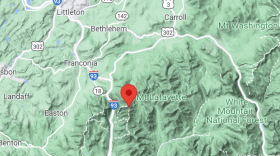There are thousands of places in New Hampshire where the natural flow of water meets a structure that humans have made: roads, hiking trails, railroads. And as New Hampshire gets wetter with climate change, the culverts and bridges that help channel those flows are facing a big challenge: They’re just too small.
In Rye, one culvert on Route 1A is getting a big upgrade — growing to four times its current size — to help accommodate rising sea levels and prevent flooding on the road. In the long-term, the growth of that culvert could also help salt marshes move upstream instead of disappearing underwater, as saltwater encroaches on the land.
That culvert could be a model of the kinds of engineering Seacoast communities will need to take on to protect roads and property from a wetter future.
The head of the National Oceanic and Atmospheric Administration, Richard Spinrad, visited New Hampshire this week to tour the site of that project, which is funded through the Bipartisan Infrastructure Law. After his tour, state and local officials gathered in a small room at the Seacoast Science Center to share the challenges and opportunities they’re seeing as they respond to sea level rise and other climate change issues.
Spinrad encouraged those gathered to look towards the benefits that can come from climate resiliency.
“All too often when we talk about resilience, we have this sort of ‘gird your loins, dig your heels in, let's protect ourselves and make sure we're not hurt, that our economy doesn't suffer, that our lifestyle is not adversely impacted,’ ” he said. “I actually believe if we do this right, we can see economic growth, we can see people more prosperous, we can see communities that are safer.”
Officials are planning to expand two culverts in Stratham, in addition to the one in Rye, through the NOAA funding. The culverts being replaced are at tidal crossings, where tide waters move under a road or other transportation infrastructure, like a railroad.
When the crossings restrict tidal movements, they can prevent salt marshes from moving upstream as sea levels rise. Salt marshes have a variety of benefits, including helping with mitigating climate change by creating a buffer between the ocean and coastal communities and by absorbing the carbon dioxide that fuels global warming.
David Rodrigue, the assistant commissioner of New Hampshire’s Department of Transportation, told the group that culvert replacement projects are important. But, he cautioned, infrastructure updates to mitigate climate impacts will require continuing investments.
“That is what’s required to be resilient and to build a climate-ready nation. And it comes at a cost that we all need to support in the long run,” he said.
After Spinrad noted that climate resilience projects are a kind of insurance, preserving property and lives in the face of increasing threats, Rodrigue said he agreed.
“We believe in preservation and maintenance as a great way of extending the life of our assets,” he said. “But if we’re choosing between plowing snow and keeping the roads safe and maintenance and preservation, plowing snow wins every time.”
Matt Thorne, the climate adaptation program manager at The Nature Conservancy, said one challenge with planning for climate change is scaling up resiliency projects.
“Three is better than one,” he said, “But three culverts is not 30.”
Thorne said the culvert project has helped expose other challenges, like the constraints on local and state funding for climate initiatives and the limited ability within municipalities to manage resilience projects.
Steve Couture, the coastal program administrator at the state’s Department of Environmental Services, said beyond the three culverts being upgraded with the federal money, New Hampshire has 20 culverts that are priorities for replacement, which could cost $25 million.
But, Couture said, the coordination between organizations and agencies on the culvert replacements is a start for tackling larger climate resilience challenges.
“We’re talking about one culvert, one road. We’re not talking about Hampton, our highest risk community, and an economic driver for the coast,” he said. “That’s a really tough conversation to have, and we’re investing a lot in that now.”








